
by Ted Beyer
The sun is, on average, about 93,000,000 miles (149,668,992 kilometers) away from us. That’s pretty darn far. In fact, if the sun went out right now, we would not know about it for about eight minutes. Not to worry, that’s not going to be a thing to fret about for quite a while—a couple of billion years last time I checked.
That huge (try 109 times as big as Earth) ball of fusion reactor up in our sky is arguably responsible for all of the energy we use on Earth. Not just solar power, but all of it. Fossil fuels (oil, coal, and natural gas) were created from ancient plant and animal matter—which all lived because of the sun.
Hydropower is only possible because of the water cycle (best look that one up on your own, they won’t let me make these posts too long). Wind power relies on, well, wind—and that is a byproduct of the warming and cooling of the atmosphere—and that’s the sun doing that warming too. Atomic power uses heavy elements like Uranium, which was created in the hearts of suns.
I could go on and on, but I think you get the idea.
So, the sun seems like a pretty interesting thing to take a closer look at, huh? Well, there’s a bit of a problem with that idea. Staring straight into the sun will cause your eyes no end of problems fairly quickly. You can—and will—suffer from a variety of unfortunate conditions: solar retinopathy, pterygium, cataracts, and even blindness.
Clearly, we need to come up with ways we can observe the sun safely. Luckily, we have a number of astronomy tools we can use to do this, and pretty soon there will really be something to see!
On Monday, August 21st, 2017, a total eclipse of the sun will be visible in the continental United States. It will follow a track very similar to the eclipse seen way back in June 1918. There have been several others since then that have brushed areas of the US; I remember the one in March 1970 (I was eight at the time) that darkened much of the East Coast. As I recall, it just got dim here in Connecticut—not totally dark. The last total eclipse to hit any part of the lower 48 was in February 1979, and that only crossed over the Northwest part of the country.
So what is an eclipse anyhow? Well, it’s the result of a dance between three players: the sun, the earth, and our moon. When the moon manages to find itself in just the right spot in the sky to cast a shadow on the earth during daylight hours, we call that an eclipse. These happen about every 18 months but more often than not, they occur in ‘inconvenient’ places.
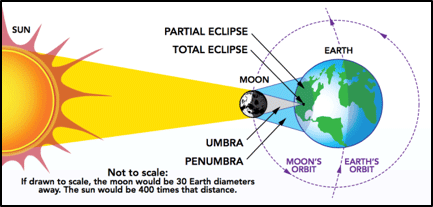
Total solar eclipse showing umbral and penumbral lunar shadows. Image source: NASA Astronomy Picture of the Day
Now, to get all technical, on the average, the length of the moon’s shadow when at the new moon phase is 232,100 miles (that’s 373,530 km for those so inclined), and the moon’s distance from Earth’s surface is, on average, 234,900 miles (378,030 km). So, when the moon passes right in front of the sun, the moon will appear ever so slightly smaller than the sun.
If you happen to be looking up (with proper safety equipment, of course!), you will see what’s known as an annular eclipse, rather than a total eclipse. An annular eclipse means there will be an immensely bright ring of sunlight still visible around the moon.
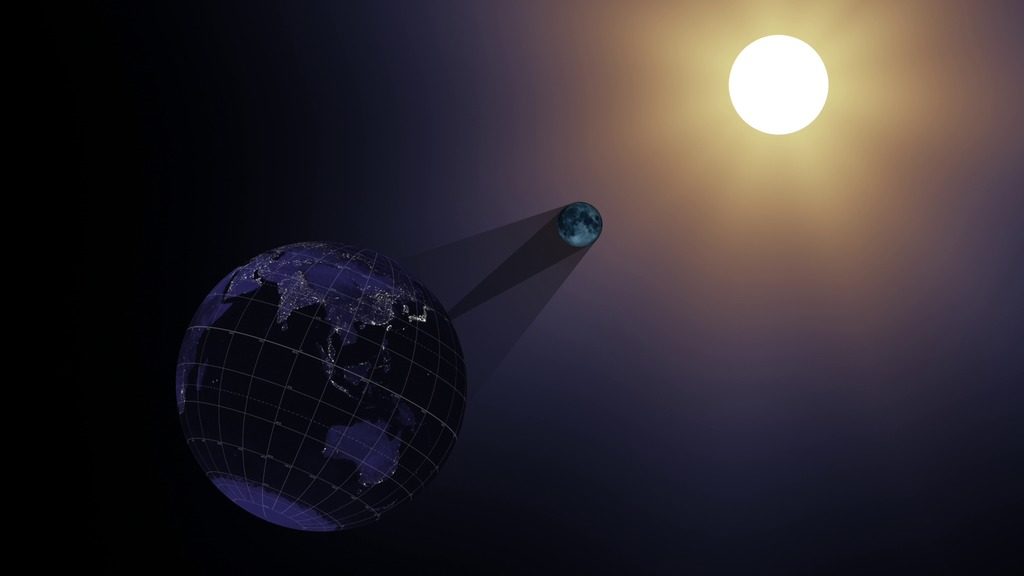
Geometry of a total solar eclipse showing the relative positions of the sun, Earth, and moon. Image source: NASA Goddard Science Visualization Lab
Obviously, total solar eclipses do occur, because the moon’s distance can vary between 217,730 miles (350,400 km) and 247,930 miles (399,000 km) from Earth’s surface. That’s because the moon’s orbit is not circular—it’s elliptical.
The tricky part comes when trying to not only calculate when all those moving parts will result in a total eclipse but where the moon’s shadow will fall. I am not one to delve into that kind of math, so let’s skip over that part and believe the guys with the computers and knowledge of celestial mechanics who say that it’s coming and that it will be a real sight to see! Feel free to check out NASA’s eclipse website for much, much more detail about the upcoming eclipse.
A view of the United States during the total solar eclipse of August 21, 2017, showing the umbra (black oval), penumbra (concentric shaded ovals), and path of totality (red) through or very near several major cities. Image source: NASA Scientific Visualization Studio
What will you see when looking at this eclipse?
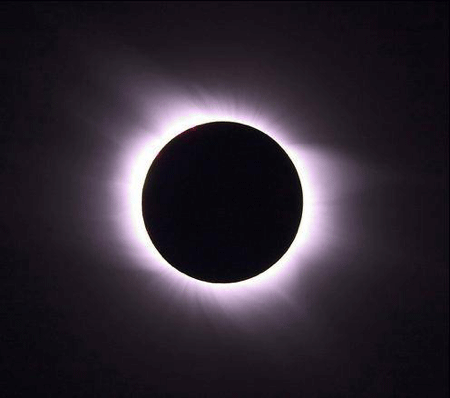
This image shows a solar eclipse at the point of totality, when the moon completely blocks out the body of the Sun, revealing the normally hidden corona. Image source: The Exploratorium
At first, it might be hard to pick out without some magnification, but there will be a tiny “dent” in the Eastern side of the sun, which will quickly grow to a huge chunk. Over the next half hour or thereabouts, you will see it progress across the sun’s surface. Although the sky will still be pretty normal, it will eventually start to become a deeper blue than usual and the surface of Earth around you will start to fade into a dull gray.
When there is still about 15 minutes until totality, half the sky will appear much darker than the other. The sun will become a crescent, but not like a crescent moon—it will still be blindingly bright. The sky will fade to an even deeper blue—maybe even purple.
Just before totality, the sky will become even darker and the sun will be a mere sliver. For just a few moments you will be able to see Baily’s Beads—the last rays of the sun spilling through the deepest valleys on the horizon of the moon. Soon, all that will be left is a ghostly white halo around the moon. This is the corona—the hottest and most extended atmosphere of the sun—shining with a spectacular pale white glow.
That’s totality. The sky will even be dark enough to see stars and planets! How long this will last depends entirely on how close you are to the center of the track of totality.
Let’s talk about some ways of looking at the sun without losing your eyesight!
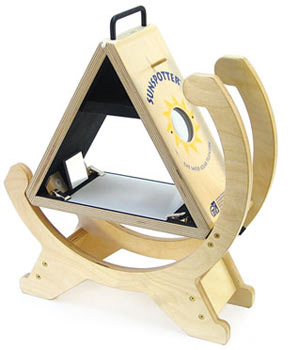 My favorite is the Sunspotter. It’s an odd looking wooden triangle with a hole filled with a lens on one side and some mirrors inside a semi-circular cradle. The beauty of this gadget is that you end up with a very nice magnified image of the sun projected onto paper so you can make sketches. With the Sunspotter, you can do all of your sun (or eclipse) observing in perfect safety.
My favorite is the Sunspotter. It’s an odd looking wooden triangle with a hole filled with a lens on one side and some mirrors inside a semi-circular cradle. The beauty of this gadget is that you end up with a very nice magnified image of the sun projected onto paper so you can make sketches. With the Sunspotter, you can do all of your sun (or eclipse) observing in perfect safety.
Setting up the Sunspotter is very simple. Simply orient it in the direction of the sun and tweak the angle and elevation so the gnomon (that little stick on the front there) does not cast a shadow. To fine-tune it, a little more tweaking will make the light that passes through two small holes in the front line up with the circles on the back of the unit. Once you have done that, you should see the sun in all its glory projected onto the observation surface.
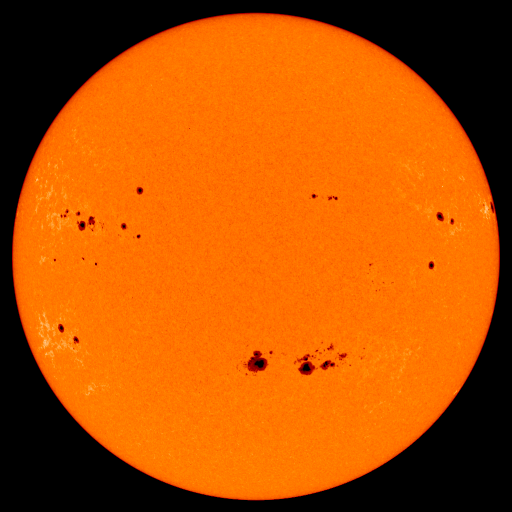
Image source: NASA
This is where things can get really interesting. You may or may not know it, but the sun has weather all its own. This takes several forms, but the easiest to see are called sunspots. Good name! They are, well, spots. On the sun. Sunspots. Catchy, huh? (There are times when it is evident that some scientists have a pretty limited imagination.)
Turns out that sunspots are concentrations of the magnetic force on the surface of the sun. These forces impede the convection currents—which are how the sun usually works—from moving as they usually do, so the temperature in that small area falls compared to the surrounding areas (trust me, they are still insanely hot). The spots most always come in pairs, with each having the opposite magnetic polarity as the other.
Using the Sunspotter, you can easily see the larger occurrences of these features, and sketch their positions. Since they usually move very quickly, two observations just a few minutes apart will confirm that they are moving, and show you the direction of their movement. Even Galileo sketched sunspots!
The size and shape will change as well. Tiny little spots when you observe them. Spots that are, in reality, more often than not, big enough to swallow up our entire planet several times over. The ones that the Sunspotter will allow you to see surely are.
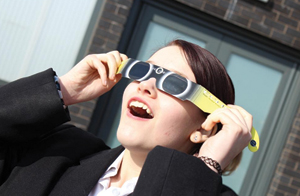 We also offer another way to observe the sun. Our Eclipse Glasses use highly specialized filters to allow you to look directly at the sun safely for up to 10 minutes at a time. Unlike the Sunspotter, these glasses do not offer any magnification, but they do allow you to observe our flaming neighbor directly. A nice feature of our Eclipse Glasses is they let you see the sun in nearly true color—instead of the green image some others offer.
We also offer another way to observe the sun. Our Eclipse Glasses use highly specialized filters to allow you to look directly at the sun safely for up to 10 minutes at a time. Unlike the Sunspotter, these glasses do not offer any magnification, but they do allow you to observe our flaming neighbor directly. A nice feature of our Eclipse Glasses is they let you see the sun in nearly true color—instead of the green image some others offer.
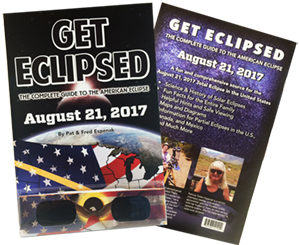 We also offer a very informative Get Eclipsed Book (which include two pairs of the glasses) with tons of facts on solar eclipses, and this eclipse in particular. We even have Eclipse HD Glasses that use the same filters as our regular glasses, but are made of a sturdy plastic material which affords a superior view.
We also offer a very informative Get Eclipsed Book (which include two pairs of the glasses) with tons of facts on solar eclipses, and this eclipse in particular. We even have Eclipse HD Glasses that use the same filters as our regular glasses, but are made of a sturdy plastic material which affords a superior view. 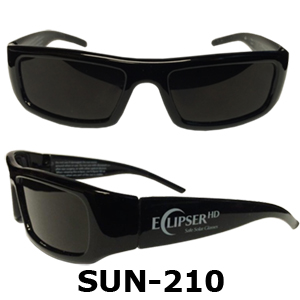
I highly recommend these if you plan on observing the sun more than just this once for the eclipse.
I hope you are lucky enough to be in the path of totality—it really is apt to be a once in a lifetime experience!
NOTE: NEVER look directly at the sun without proper filters in place. DO NOT observe the sun with any magnifying apparatus such as binoculars, telescope, etc. without a filter SPECIFICALLY DESIGNED for use with such a device. Our glasses are NOT intended for this purpose and should not be used with any magnifying apparatus.

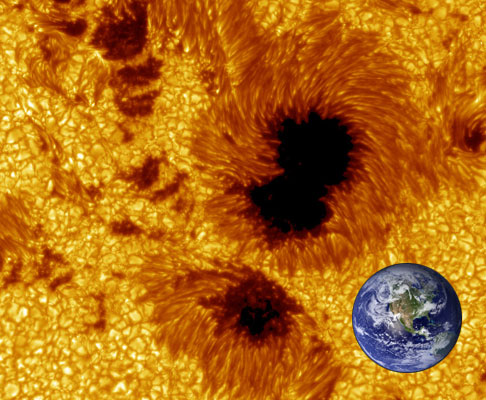
I will translate some of these into Chinese for my daughter’s reading. I think my daughters are more interested in sky science.
It is very interesting content and explained nicely.
We bought glasses from you and they do not have the ISO marking. How do we know they aren’t fake?
Every single pair of glasses sold at Educational Innovations had the ISO marking inside the glasses. Our vendor, American Paper Optics, was one of the few NASA approved manufacturers of eclipse glasses. If you have glasses without ISO markings, you should NOT use them to look at the sun.